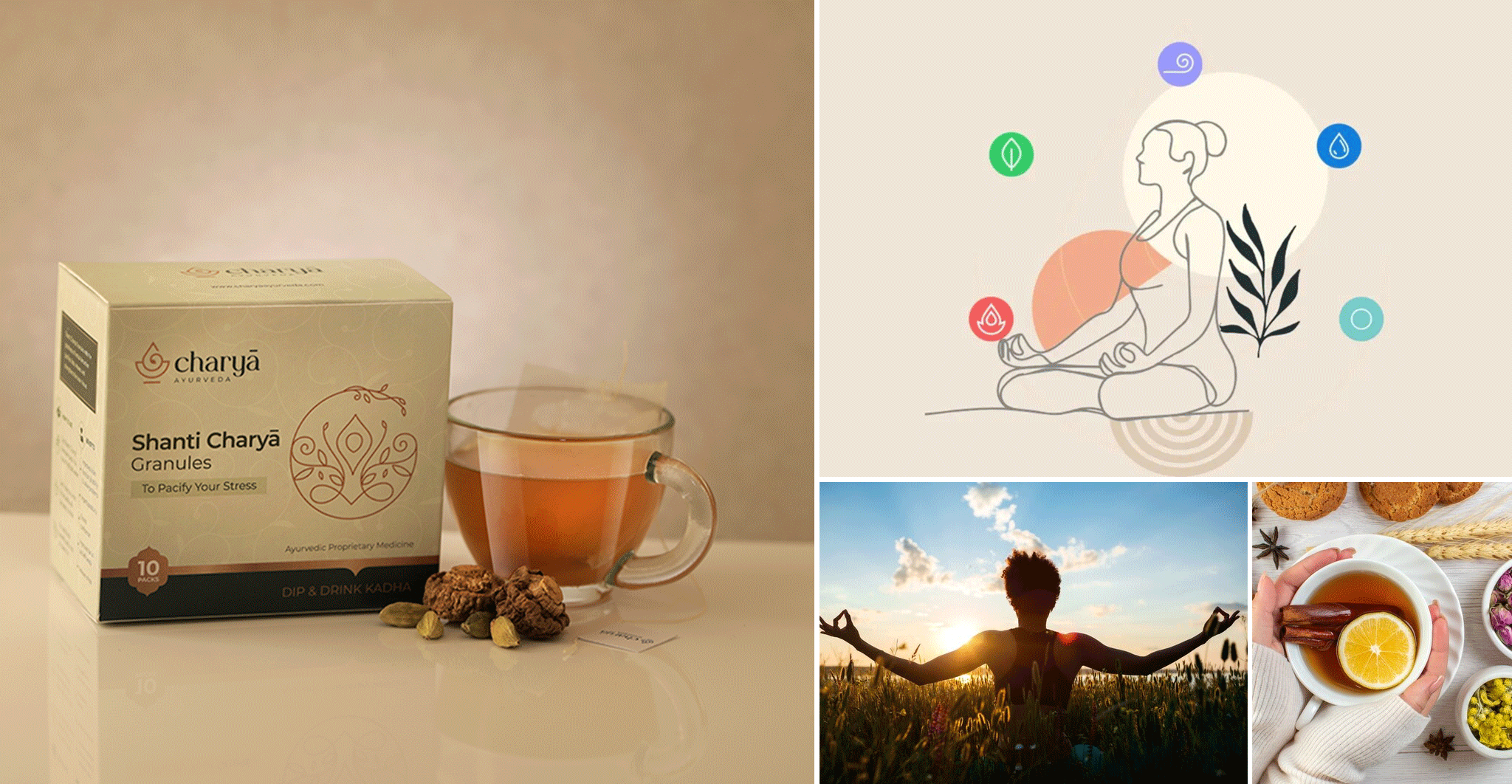Your cart is currently empty!
Charya for a Healthy Uterus

In different phases of life, women face several changes in their bodies. Being a teenager facing the red stain for the first time, giving birth to a new life in this world, and many hormonal changes. These changes in the body are associated with an incredible part of the body known as the UTERUS or womb.
Uterus in Ayurveda, known as “Garbhashaya” plays a vital role in a woman’s life. A healthy uterus promotes a healthy menstrual cycle, hormone levels, pregnancy, and overall women’s health. So, it is necessary to provide the care and health it deserves.
But how does one achieve that, what are the Ayurveda takes on the uterus and many more? Let’s dive deeper into the blog to get the answers to all these questions.
Ayurveda perspective on the uterus
Uterus or Garbhashaya consists of two meaningful terms i.e.”Garbha” means fetus and “Ashya” means residence. It is part of the female reproductive system where the fetus resides and grows for nine months.
A healthy Garbhashaya has several health benefits like hormonal balance, proper growth of the fetus, reproductive health, and overall well-being.
However, Acharya Charaka explains uterine problems that can alter the healthy state of the uterus in chapter 30 explains the main causes of it.

Which explains:
The main four reasons for the occurrence of uterine issues include:
- Mithya Ahar Vihar – Following false dietary and lifestyle habits
- Pradushta Artava – Abnormalities related to menstruation or ovum
- Beeja Dosha – Abnormalities of sperm or ovum
- Daiva – Godly or Fate
Ayurveda Perspective on the Menstrual Flow
Menstrual flow is a phenomenon that includes the flow of blood from the uterus through the cervix from the vagina as a result of the shedding of the endometrium layer inside the uterus every month.
Talking about Ayurveda’s perspective, the menstrual flow is said to be the upadhatu of “Rasa dhatu” or plasma. Rasa dhatu is formed from the food we consume. A good quality of food will enhance the quality of your “Rasa” and other dhatus.
Tridosha also plays a role in facilitating the whole menstrual cycle from the beginning of ovulation, where the Pitta dosha helps in the maturation of a fertilized egg. If fertilization doesn’t occur, Vata dosha initiates menstrual flow. Later after menstruation, Kapha dosha brings a sense of calmness, peace, and prosperity to a woman.
Ideal Menstrual Flow Which Indicates Health as per Ayurveda
Menstruation is a natural process a woman goes through. The menstrual cycle ranges from 28-30 days and usually lasts 3-4 days.
As per the Ayurveda texts, a healthy menstrual flow must have the following properties:
- Bright red
- Doesn’t stain the cloth or even if stains, then it must be easily cleaned
- Must not have a foul odour
- The amount must be 4 Anjali (1 Anjali is equal to the amount that would cover your cupped palms)
Effects of Imbalanced Tri-Doshas on Menstruation
Ayurveda uniquely examines the menstrual cycle as a window into the human body. By being aware and in tune with your menstrual cycle, you can figure out very clearly, on a month-to-month basis, which dosha imbalances your body is stumbling with.
All three doshas show their effects on menstruation.
Vata dosha-oriented issues
In a normal state, Vata dosha initiates the menstrual period. Vata enables movement due to its ‘chala’ feature. It serves as a moving force and initiates menstrual flow. However, the imbalance of Vata dosha during menstruation leads to the following symptoms:
- Discomfort – Sharp throbbing and pricking pain in the lower abdomen and back
- Emotional – Fear, anxiety, and nervousness
- Menstruation – Irregular periods, scanty flow and dark-coloured discharge
- Miscellaneous – Sensation of creeping ants and stiffness
Vata-pacifying diet and lifestyle –
- Eat warm foods
- Freshly cooked food
- Include plenty of ghee
- Add seeded black raisins, and dates to the diet
- Include seeds like Methi (fenugreek), garden cress, Ajwain, and fennel seeds for ovulation
- Nabhi Puran with castor oil
- Pranayama and Yoga
- Avoid exertion during menstruation
You can also try Sukhada Granules – DIP & DRINK KADHA
It is a kadha that corrects the imbalance of Vata dosha in your uterus and resolves other menstrual issues.

Pitta dosha-oriented issues
Balanced Pitta dosha facilitates the engorgement of endometrium, in preparation for the fertilized egg. However, the imbalance of Pitta dosha during menstruation may cause the following symptoms:
- Discomfort – Burning sensation
- Emotional – Irritability and anger
- Menstruation – Sense of warmness in flow, red coloured, flesh smelling, heavy flow
- Miscellaneous – Increased body temperature, nausea, vomiting, headache, acne, and diarrhoea
Pitta-pacifying diet and lifestyle –
- Include black raisins, figs
- Ghee is a must
- Medicated water with coriander seeds
- Amla murabba
- Cooling foods and fruits like pomegranate, amla, gulkanda
- Avoid sour, salty foods, like chips, pickles, etc
- Massage your breasts if facing tenderness
- Nasya
- Nabhi Puran with Coconut oil
- Pranayama and Yoga
Kapha dosha-oriented issues:
Kapha dosha in an equilibrium state performs its function of thickening the endometrium and its growth along with a sense of relaxation and peace at its best. However, symptoms associated with imbalanced Kapha dosha during menstruation are:
- Discomfort – Less pain and discomfort, itching
- Emotional – Depression and sadness
- Menstruation – Pale coloured, clots and mucoid
- Miscellaneous – Bloating, heaviness, excessive itching, increased sleep
Kapha-pacifying diet and lifestyle –
- Include spices like dry ginger, black pepper, turmeric
- Avoid daytime sleep
- Use warm foods
- Avoid heavy and fatty diets
- Stay active
- Exercise
- Nabhi puran with Castor oil or sesame oil
- Pranayama and yoga

Top 16 tips for your Menstrual Well-Being
A menstrual phase is full of changes, mood swings, cravings and hormonal imbalances leading to several transformations in your body. To manage those changes and keep your body in equilibrium, you must follow:
- Include seeds or seeded foods
- Keep yourself and your genitals clean and maintain proper hygiene. You can give it a try to Naari Charya – DIP & WASH KADHA for your intimate well-being, an Ayurvedic herbs-induced product that facilitates appropriate cleaning of your genitals
- Practice meditation
- Consume a favourable diet according to dosha composition
- Introduce Sukhada Granules to your daytime beverage to facilitate a healthy menstrual wellbeing
- Practice naval oiling daily with sesame oil
- Make sure to include naturally grown, seasonal and local food
- Practice yoga – especially poses involving pelvic and lower abdomen
- Pranayama – Anulom vilom under proper trainer/guidance
- Ensure proper rest during menstruation
- Avoid scrubs, facials, oil massage and exercise during menstrual flow
- Practice dinacharya mentioned in Ayurveda
- Body massage with oil at least once a week
- Daily nasya for hormonal balance, stress relief and mental balance
- Avoid genetically modified seedless food
- Avoid packaged, ready, or frozen foods
Understand more about the menstrual care and routine to be followed in our blog – “Rajaswala Charya”
Basic Guidelines for a Healthy Menstrual Cleanse
Following proper menstrual hygiene helps to prevent infections, reduce odour and have a comfortable period,it includes:
- Wash your hands before and after using any menstrual product
- Do not stress
- Pamper yourself with rest and rejuvenation
- Don’t suppress urges
- Wear breathable underwear to prevent infection
- Change your menstrual products on time
- Keep your genitals clean
- Discard your menstrual products properly after use
Uterine Tonics and Herbs in Ayurveda
There are various herbs and uterine tonics available in the market that promote good uterine health. Some of them are:
- Herbs like Ashoka, Shatavari, Manjishtha and Lodhra have a positive effect on uterine health
- Sukhada Granules, a Dip and Drink kadha to help you fight your cramps and provide a soothing effect during menstruation
- Introduce self-made herbal teas to your routine. For example, warm water induced with Lodhra or carom seeds may help you bring relief to your painful cramps
Conclusion
Many women suffer from various hormonal imbalances, menstrual issues and cramps problems. Due to these reasons, periods might sometimes be burdensome, frustrating and annoying part of life. To combat all these issues, make sure to keep your uterus healthy.
To be precise the concern, the uterus is indeed an organ to be cherished. It provides you with various reproductive, hormonal and health benefits. Therefore, it is a must to take care of the uterus.

Recommended Products
More from Charya

5 Ayurvedic Brightening Herbs For Glowing Skin
Vd. Shweta Labde

Know Your Charyā- Your Ayurvedic Wellness Code
Shweta Labde

Hemant Ritucharya- An Ayurvedic Guide To Holistic Winter Routine
Vd. Shweta Labde










Leave a Comment